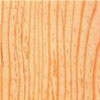Douglas Fir

| Wood type | Softwood |
| Environmental | Not listed in CITES. Believed available from well-managed sources. Check certification status with suppliers. |
| Introduction | Douglas fir from Canada and the USA may be graded and shipped for structural purposes in the species mix ‘Douglas fir- larch’ which comprises Douglas fir (Pseudotsuga menziesii) and western larch (Larix occidentalis). The mechanical properties quoted for material from Canada and USA are for this species mix. |
| Distribution | Although a native of North America, the tree has been extensively planted in Europe and the UK. |
| The Tree | A large tree attaining a height of 45m to 60m and a diameter of 1m to 2m, occasionally much taller and larger |
| The Timber | The heartwood is light reddish-brown in colour, usually quite distinct from the lighter coloured sapwood. The abrupt change and contrast in colour between early-wood and late-wood bands, produce a prominent growth ring figure which is a feature of plain-sawn surfaces and of rotary-cut veneer. The wood from trees grown in the UK appears to have less resin than the North American wood, and to some extent is of more rapid growth. The average weight of dried timber from either source is about 530 kg/m3. |
| Drying | Imported ‘Douglas fir’ is not a difficult timber to dry on arrival in this country or in Europe, because the moisture content has already been reduced prior to shipment with some selecting out of degraded boards. Drying degrade is generally confined to surface checking, splitting and loosening of knots, and splitting in the vicinity of knots. Accordingly, stock from trees grown in the UK and in Europe when dried from the green state, needs care, particularly because of the generally higher preponderance of knots which are hard, often loose, and which encourage more wavy grain than in imported stock. |
| Strength | Compared with European redwood, it is some 60 per cent stiffer, 40 per cent harder and more resistant to suddenly applied loads, and 30 per cent stronger in bending and in compression along the grain. |
| Durability | Moderately durable |
| Treatability | Extremely Difficult |
| Moisture Movement |
Small |
| Density (mean, Kg/m³) |
530 |
| Texture | Medium |
| Availability | Regular |
| Price | Medium |
| Sizes | Long lengths and clear grades available |
| Use(s) | Exterior joinery, Interior joinery, Plywood, Cladding |
| Colour(s) | Reddish brown, Light brown |
